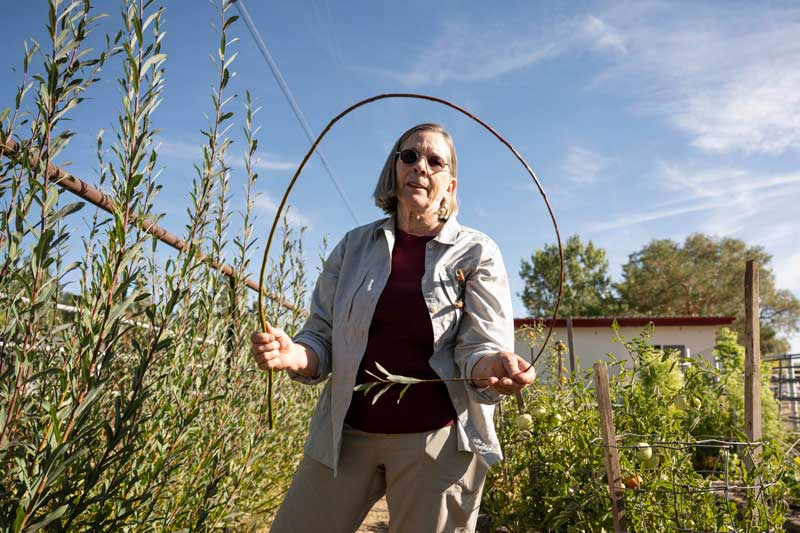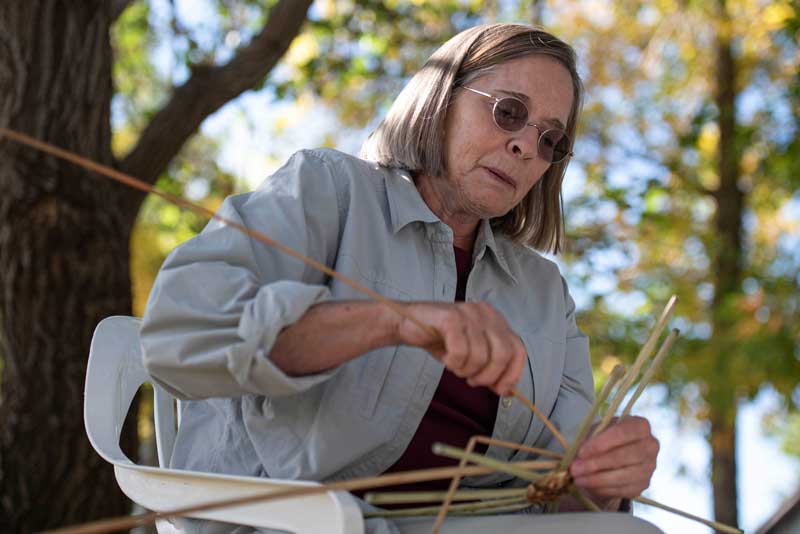Local basketmakers use ancient techniques and materials for modern and utilitarian functionality.
For thousands of years, baskets have been crafted and designed by Native people in North America and Europe as essential tools for the kitchen and garden. Today, baskets still are just as important, offering functionality in a number of new and traditional roles.
In the past, Sue Ann Monteleone, a Reno-area basketmaker with Great Basin Basketmakers, has made a bread-proofing basket for a friend, in which dough is placed to help develop a better crust. She also has seen and made baskets for gathering garden vegetables and herbs, fishing creels, and a backpack, and she read of lobster traps made from willow and baskets for straining pasta.
Monteleone was an archeologist who transitioned her career into basketmaking after working with the basket collection at the Nevada State Museum in Carson City.
“[I] was fascinated with how things were made,” she says. “It is my second most favorite thing in life after my family. It’s kind of amazing how it’s become such a focus in my life.”
Most modern baskets are made using traditional techniques — plaiting, coiling, twining — and a variety of locally grown materials. Willow and tule are two of the most common because of their strength and beauty.
Tule is a large marsh rush that grows in proximity to cattails in any basin that has water. Also called bull rush, tule can be transformed into kitchen utensils, boats, or gathering baskets.
In the kitchen, tule can be woven into bags to hold garlic as well as table mats or floor mats. A company out of the United Kingdom called Rush Matters harvests barges of tule and transforms it into “carpet” that extends wall to wall.
Willow, which grows all over the world, makes a sturdy basket because of its density and strength. European basketry leans heavily on willow for farming and kitchen uses, including planter beds and fishing baskets. In the past, even wagons and houses have been made using willow.
“This may sound silly, but a willow basket smells so good,” said Bonnie Kennedy, a Reno-based basketmaker with Reno Open Studios. “Because willow is not processed and is used in its natural state, it looks so much more organic than other materials.”
Because willow is not as easy to weave with as other materials, doing so requires using a few different processes and tools.
“You have to let the willow work for you,” Kennedy says. “You don’t work for it.”
Harvesting willow, a process called coppicing, is performed after the leaves fall off and before they bud, so around winter. You coppice, or cut back to ground level periodically to stimulate growth, only the long withes (the tough, flexible branches) that grow with no branches from them. These withes should be four to six feet long. All the cut ends are put together by size and length and kept submerged in water for a period of time.

Sue Ann Monteleone demonstrates the pliability of freshly cut willow
“I have found once they are soaked for 10 days, if they mellow (stay damp, not wet) for a couple of days, they are easier to weave with,” Kennedy says.
Area basketmakers also use unexpected recycled materials in their work.
“I have woven with just about anything you can think of,” Kennedy says. “Willow, reed, pine needles, tule, cedar bark, birch bark, leather, recycled plastic bags, maps, paper, yarn, parachute cord, copper wire, fabric, T-shirt yarn, milk cartons … to list a few. The possibilities are endless.”
Ashley Johnson is a Lake Tahoe-based freelance writer focused on enjoying and dishing out the latest on local trends, tech, and wellness-focused businesses.
RESOURCES
For details about basketmaking or to take a class, visit Great Basin Basketmakers at Greatbasinbasketmakers.org, Rush Matters at Rushmatters.co.uk, or Reno Open Studios at Renoopenstudios.org.


